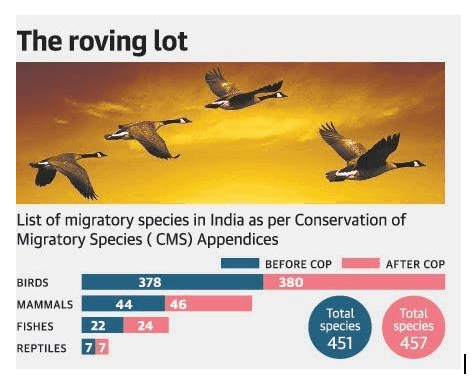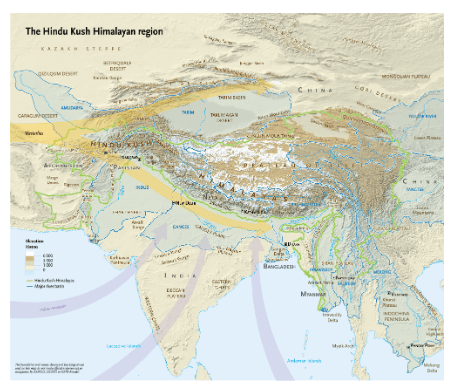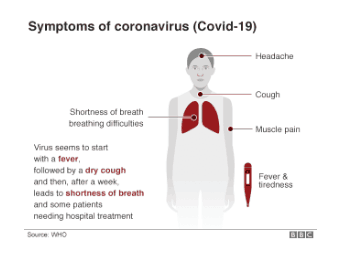IASbaba's Daily Current Affairs Analysis

IAS UPSC Prelims and Mains Exam – 2nd March 2020
Archives
(PRELIMS + MAINS FOCUS)
India is host to 457 migratory fauna
Part of: GS Prelims – Environment and GS Mains III- Conservation
In news:
- The total number of migratory fauna from India comes to 457 species
- Birds comprise 83% (380 species)
- Zoological Survey of India (ZSI) had for the first time compiled the list of migratory species of India under the CMS before the Conference of Parties (COP 13)
- The Asian elephant was added to Appendix I and the urial to Appendix II.
- The largest group of mammals is definitely bats belonging to the Family Vespertilionidae.
- Dolphins are the second highest group of mammals with nine migratory species of dolphins listed

Daily Current Affairs IAS | UPSC Prelims and Mains Exam – 2nd March 2020
Source: The Hindu
From Prelims Point Of View
Convention for the conservation of migratory species or Bonn Convention
- Signed in 1979 in Germany and is known as the Bonn Convention
- Environmental treaty of the UN that provides a global platform for the conservation and sustainable use of migratory animals and their habitats
- Only global convention specialising in the conservation of migratory species, their habitats and migration routes.
- Appendix I of the Convention lists ‘Threatened Migratory Species’.
- Appendix II lists ‘Migratory Species requiring international cooperation’
Water crisis looms large in Himalayan regions
Part of: GS Prelims – Geography and GS Mains I- Climate change
In news:
- Eight towns in the Himalayan region of Bangladesh, Nepal, India and Pakistan were nearly 20%-70% deficient in their water supply,
- Unplanned urbanisation and climate change are the key factors responsible for the state of affairs,
- The places surveyed are extremely dependent on springs (ranging between 50% and 100%) for their water, and three-fourths were in urban areas
- Under current trends, the demand-supply gap may double by 2050
- only 3% of the total Hindu Kush Himalayan population lives in larger cities and 8% in smaller towns, projections show that over 50% of the population will be living in cities by 2050
From Prelims Point Of View
Hindu-Kush-Himalayan (HKH) Region
- Afghanistan, Bangladesh, Bhutan, China, India, Kyrgyzstan, Mongolia, Myanmar, Nepal, Pakistan, Tajikistan, and Uzbekistan.
- 5 million square kilometres considered the Third Pole (after the North and South Poles
- Significant implications for climate. vast cryospheric zones and is also the world’s largest store of snow and ice outside the polar region.

Daily Current Affairs IAS | UPSC Prelims and Mains Exam – 2nd March 2020
Source: The Hindu
Pakke Tiger Reserve
Part of: GS Prelims – Environment and GS Mains III- Conservation
In news:
- Recently there was an opposition to not to pursue a proposed highway through the ‘nationally important’ Pakke Tiger Reserve.
From Prelims Point Of View:
Background:
- Lies in the foothills of the eastern Himalaya in the East Kameng district of Arunachal Pradesh. It is also known as Pakhui Tiger Reserve.
- Falls within the Eastern Himalaya Biodiversity Hotspot.
- Known for its amazing sightings of four resident hornbill species.
- India is home to nine species of hornbills. three of them, the wreathed hornbill (Aceros undulatus), the brown hornbill (Anorrhinus austeni) and the Rufous-necked hornbill (Aceros nipalensis)great hornbill is the state bird of Arunachal Pradesh and Kerala.
- It is ‘vulnerable’ under the IUCN Red list.
- Hornbill festival celebrated in Nagaland is named after the bird – Hornbill which is the most revered and admired bird for the Nagas.
Puttenahalli lake under threat
Part of: GS Prelims – Environment and GS Mains III- Conservation
In news:
Puttenahalli lake
- Puttenahalli lake is a small, restored freshwater lake located in Bangalore.
- The primary water sources are rain and surface water diverted to the lake through channels.
- The lake is currently maintained by Puttenahalli Neighbourhood Lake Improvement Trust (PNLIT)
- The lake was on the brink of extinction, but due to the efforts of PNLIT, is now a haven for bird-watchers and on its way to being completely restored.
Fears rise as COVID-19 cases, deaths hit new high
Part of: GS Prelims – Health and GS Mains II- Health
In news:
- The number of countries hit by the COVID-19 outbreak climbed past 60
Coronavirus
- Coronaviruses are a specific family of viruses, with some of them causing less-severe damage, such as the common cold, and others causing respiratory and intestinal diseases.
- A coronavirus has many “regularly arranged” protrusions on its surface, because of which the entire virus particle looks like an emperor’s crown, hence the name “coronavirus”.
- Apart from human beings, coronaviruses can affect mammals including pigs, cattle, cats, dogs, martens, camels, hedgehogs and some birds.
- So far, there are four known disease-causing coronaviruses, among which the best known are the SARS coronavirus and the Middle East Respiratory Syndrome (MERS) coronavirus, both of which can cause severe respiratory diseases.

Daily Current Affairs IAS | UPSC Prelims and Mains Exam – 2nd March 2020
SRC: BBC
(MAINS FOCUS)
Governance
Topic: General Studies 2:
- Government policies and interventions for development in various sectors and issues arising out of their design and implementation.
- Statutory, regulatory and various quasi-judicial bodies.
National Population Register (NPR)
Context: Bihar Assembly passed a unanimous resolution stating that there is no need for a National Register of Citizens in the State and that the implementation of the NPR would be done strictly according to the 2010 format.
What is NPR?
- NPR is a register of usual residents of the country. It includes both Indian citizens as well as a foreign citizen.
- According to the Citizenship Rules, 2003, a usual resident is a person who has resided (or intends to reside) in a local area for the past 6 months
- The entire NPR exercise will be conducted by the Office of the Registrar General of India (RGI) under the Union Home Ministry.
- The first NPR was prepared in 2010 and updation of this data was done (except in Assam and Meghalaya) during 2015 by conducting door to door survey.
- The present NPR has a database of 119 crore residents.
- The NPR 2020 enumeration exercise will be undertaken during April–September 2020
How is the NPR linked to the National Register of Citizens?
- NPR is considered to be the mother database for “identity purposes”.
- The Citizenship (Registration of Citizens and issue of National Identity Cards) Rules, 2003 mandates that particulars of “every family and individual” in the NPR would be used for verification in the National Register of Citizens (NRC)
- The Local Registrar is empowered, during verification, to mark out the particulars of individuals whose citizenship is doubtful, with “appropriate remarks” for further enquiry.
What happens if individual citizenship is marked doubtful?
- The individual concerned has to then appear before the Sub-district or Taluk Registrar of Citizen Registration to prove s/he is a citizen before a formal decision is taken to include or to exclude their particulars in NRC
- The onus to prove s/he is a citizen is entirely on the individual concerned.
- Thus, the data collected through NPR becomes the crux for determining the citizenship of a person.
What is the NPR format of 2010?
- Fifteen identity particulars of the individual members of the household are sought in the 2010 format.
- These include name, relationship to the head of the household, sex, date of birth, marital status, educational qualification, occupation/activity, names of parents, place of birth (of everybody staying in the household at the time), nationality, present address of usual residence, duration of stay at the present address and permanent residential address.
What does the updated NPR manual of 2020 say?
- Certain new information will be collected like Aadhaar, mobile, voter ID, passport and driving licence, if available with the residents on a voluntarily basis.
- New format also requires residents to disclose their mother tongue and the places & dates of birth of their parents even if they are not living in the same household at the time or not alive
What is the problem?
- Lack of Documentation: In a country where a large part of the population is underprivileged and where people have not been able to formalise their birth due to lack of access to health care, the task of disclosing the exact birth and place of birth, especially of their aged parents and orphans, would prove to be a daunting task.
- Fear of Exclusion: NPR is being viewed in fear as a facilitator for the NRC. Along with this, the passage of Citizenship (Amendment) Act,2019 has induced fears among sections of society (particularly Muslims) that inadequate documents may invite remarks by local registrar during enumeration exercise, thus stripping off their citizenship status.
- CAA, 2019 fast-tracks citizenship-by-naturalisation process of persons from six religious communities, other than Muslims, who have fled persecution from Pakistan, Bangladesh and Afghanistan.
- State governments are nervous that the NPR data would be used to target citizens on the basis of their identity and deprive them of their public services
What lies ahead?
- The workforce for updation of NPR 2020 has to be provided by the State governments.
- With more States objecting to the new format and its contentious clauses, the exercise may reach an impasse.
- Widespread doubts about the intentions behind the NPR may also affect the smooth conduct of the Census.
Connecting the dots
- What happens when State & Centre reach impasse (suppose in case of NPR)? Should Judiciary get involved or should mechanism like Inter-State Council be utilized?
- Cooperative Federalism
- Article 131 of Indian Constitution
International Affairs
Topic: General Studies 3:
- India and its neighborhood- relations.
- Effect of policies and politics of developed and developing countries on India’s interests
US-Taliban pact (Doha Agreement)
After nearly a year long negotiation, USA has signed a peace agreement with Taliban (Afghan government not a signatory). India attended the signing ceremony in Doha, and was represented by Ambassador to Qatar.
Separately, a joint declaration between the Afghan government (Islamic Republic of Afghanistan) and the US was issued in Kabul.
Brief background to the deal
- USA went into Afghanistan in October 2001, a few weeks after the 9/11 terror attacks, with the goals of defeating terrorists (particularly Al-Qaeda) and rebuilding and stabilising the country.
- USA’s war in Afghanistan is said to be the longest war (19 years) in its history.
- The Afghan war is estimated to have cost $2-trillion, with more than 3,500 American and coalition soldiers killed.
- Afghanistan lost hundreds of thousands of people, both civilians and soldiers.
- After all these, the Taliban is at its strongest moment since the U.S. launched the war. It now controls half of the country, mainly in its hinterlands.
- The war had entered into a stalemate long ago and the U.S. failed to turn it around despite both American Presidents Barack Obama and Donald Trump having sent additional troops.
- Faced with no other way, the U.S. just wants to leave Afghanistan.
Key elements of the US-Taliban Pact:
- Troops Withdrawal:The US will draw down to 8,600 troops in 135 days from the present 14000 troops. And all troops will be out within 14 months.
The alliance and its partners in Afghan security mission, known as “Resolute”, would reduce their military presence in the country in recognition of the new agreement. At present, resolute consists of 17000 troops from 39 countries
- Taliban Commitment: Taliban will not allow any of its members, other individuals or groups, including al-Qaeda, to use the soil of Afghanistan to threaten the security of the United States and its allies (does not include India)
- Intra-Afghan Negotiations: Taliban would engage with Kabul government directly from March 10th to find a lasting solution to the civil war
4.Sanctions Removal: UN sanctions on Taliban leaders to be removed by three months (by May 29) and US sanctions by August 27.
Pakistan has been accused of giving refugee to some these sanctioned persons and this has been one of the reasons for Pakistan being in FATF grey list (supporting terrorists)
- Prisoner Release: Up to 5,000 imprisoned Taliban and up to 1,000 prisoners from “the other side” held by Taliban “will be released” by March 10 — which is when intra-Afghan negotiations are supposed to start, in Oslo
- Ceasefire: The agreement states ceasefire will be simply “an item on the agenda” when intra-Afghan talks start, and indicates actual ceasefire will come with the “completion” of an Afghan political agreement.
Part II of the article – will deal with Challenges w.r.t the deal and Implications of deal on India
Connecting the dots
- P5+1 deal with Iran
- Impact of Taliban’s victory on the other extremists in the region
(TEST YOUR KNOWLEDGE)
Model questions: (You can now post your answers in comment section)
Note:
- Correct answers of today’s questions will be provided in next day’s DNA section. Kindly refer to it and update your answers.
- Comments Up-voted by IASbaba are also the “correct answers”.
Q 1. Which one of the following is not essentially a species of the Himalayan vegetation?
- Juniper
- Mahogany
- Islver fir
- Spruce
Q 2. Consider the following protected areas:
- Bandipur
- Bhitarkanika
- Manas
- Sunderbans
Which of the above are declared Tiger Reserves?
- 1 and 2 only
- 1, 3 and 4 only
- 2, 3 and 4 only
- l, 2, 3 and 4
Q 3. The term M-STRIPES’ is in the context of
- Captive breeding of Leopards
- Maintenance of Tiger Reserves
- Indigenous Satellite Navigation System
- Security of National Highways
Q 4. In which of the following regions of India are you most likely to come across the ‘Great Indian Hornbill’ in its natural habitat?
- Sand deserts of northwest India
- Higher Himalayas of Jammu and Kashmir
- Salt marshes of western Gujarat
- Western Ghats
ANSWERS FOR 29 FEB 2020 TEST YOUR KNOWLEDGE (TYK)
| 1 | A |
| 2 | A |
| 3 | C |
| 4 | A |
Must Read
About Nehru :
About protests and their response by the government :
About impact of Coronavirus:











